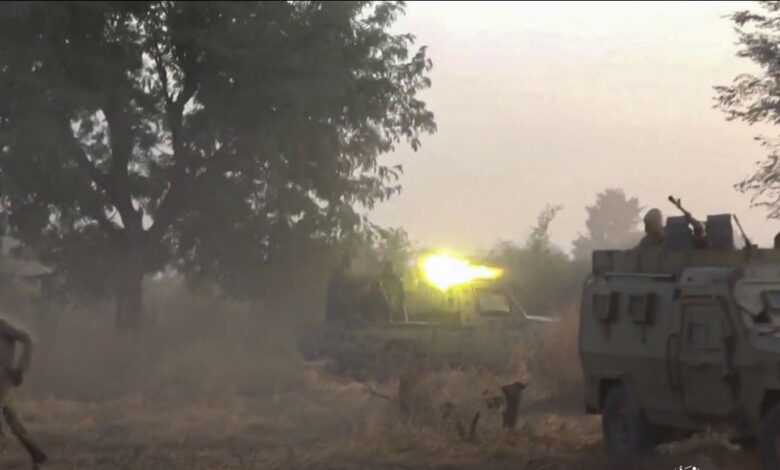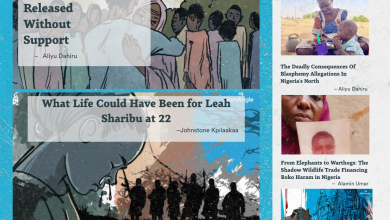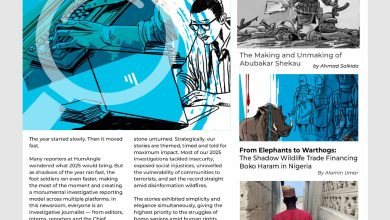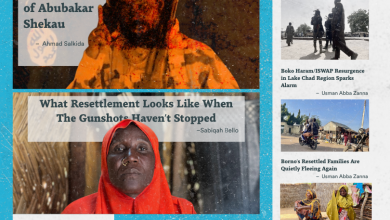ISWAP’s Pledge To New ISIS Leader Shows Transformation
The pledges provide a window into the group's mutation and marks the first pledge of allegiance by a new subgroup, ISWAP Central Nigeria.

The Islamic State West African Province (ISWAP)’s pledge of allegiance to the new leader of the Islamic State, or Bay’ah in Arabic, gives a window into its capabilities and the group’s transformation in the past year.
Over the past few days, several ISWAP subgroups of varying size and capacity have appeared in propaganda materials pledging loyalty to Abu al-Hussain al-Hussaini al-Qurashi. The new leader was appointed after the death of the former leader, Abu al-Hassan al-Hashimi al-Qurashi.
It provides a small glimpse of the structure and capability, including how they have expanded into the former Boko Haram territories. It further confirms their organisational structure, which allows several groups to operate semi-autonomously.
Under this structure, the subgroups are able to manage their areas of influence to a degree as they see fit. This gives them some level of control over their affairs and could make integration of former Boko Haram areas much easier.
This approach involving five operating units from Lake Chad, Al Farouq, Kerenoa, Sambisa, and Banki was first made public after the appointment of Abu al-Hassan in the first quarter of the year, following the death of his predecessor Abu Ibrahim al-Hashimi al-Qurashi, in a raid by U.S. special forces in northwest Syria.
The major difference revealed by the recent set of pledges is the appearance of the cells described as ISWAP central Nigeria. The group was first announced in a previous Ramadan photoset earlier in the year.
HumAngle has previously reviewed the activities of these cells located in new “active” frontiers far away from the centre of gravity in the Lake Chad basin. The group has been responsible for the use of Improvised Explosive Devices (IED) and attacks on security forces. The attacks on vulnerable police units could also be a way of collecting firearms.
These attacks have occurred in northeastern Taraba and the North-central states of Kogi and Niger. In addition, other incidents were recorded in the States of Ondo in the Southwest and Edo in the South-south. The group also claimed responsibility for attacks in the Capital, including the jailbreak at a custodial facility in the Kuje area and the attack on a military unit around Zuma rock.
HumAngle understands that the threat from ISWAP caused several western governments’ to elevate the security risk assessment for the capital in October.
What they allow us to see
The newly-promoted central subgroup didn’t give many details. Fighters appeared to have taken strict security measures, including concealing their faces by wrapping their heads in cloth, and even blurring the gap allowed for their eyes. Two individuals go as far as wearing gloves, preventing any form of possible identification. The pictures are taken indoors. One member is wearing a printed T-shirt on which a distinctive logo has been blurred.
In the released photos observers can see ten individuals over what appears to be two different rooms with pictures taken by two different cameras. Both locations have Islamic State banners placed on the walls. These banners appear to have been printed on a shiny material and then tightly folded before being hung on the wall, possibly indicating they were sent to the groups avoiding the need to print this material locally.
One of the men holds a pistol, the type of which could not be determined.
Each of the subgroups seems to have a differing degree of capability. Bearing in mind the pictures do not represent a complete picture of their offensive equipment or personnel numbers, it does give an opportunity to assess their stockpile and reuse of weapons from regional forces.
In the propaganda material, the group showed several weapons, including assault rifles. Most notable were the ex-Cameroonian Zastava M21s and ex-Nigerian Beryl M762 and AK-74, alongside Galil ACE 32, likely captured from Chadian forces.
Some of the trucks on display had different variants of heavy machine guns, such as the NSV deployed as a ground assault and anti-aircraft weapon system. In addition, fighters had other arms, including RPGs and Russian made PK machine guns and a much rarer M60 belt-fed machine gun likely seized from the Nigerian forces.
The first oath to the new leader was from the Sambisa group, which would have included former Boko Haram fighters. It was seized after the ISWAP conquest last year and the death of rival group leader Abubakar Shekau.
The fighters present in a small group of perhaps 40-50 men. There is a high degree of variability in their combat clothing. Some of the fighters show their personalised battle smocks, made to an individual’s specifications. They carry personal equipment likely looted from soldiers, like camel water packs and webbing harnesses. Some of the fighters have boots, others wear thick ankle-high socks and flip flops.
The next pledge was the Lake Chad area, an important part of ISWAP’s area of influence which provides military and social-economic opportunities for the group’s sustenance.
The fighters in this group displayed a high degree of unanimity in clothing and equipment, they invariably have black, or sand coloured battle dress and military desert boots. The picture shows at least 70 men, probably many more are present out of frame.
This was followed by the one from the al-Farouq area, presumably referring to the Alagarno forest/Timbuktu Triangle areas.
This area is a significant stronghold supporting operations such as attacks on security forces and mounting checkpoints alongside movement across a vast swath of lands in Borno and Yobe.
The fourth ISWAP pledge was from the group in Banki, an area in central Borno not far from the Sambisa forest. Both areas previously under the sphere of Boko Haram have seen an exodus of fighters, captives, conscripts, and civilians. Here again, there is a mix of dress styles. In one of the pictures the muzzle of a DShK anti aircraft gun mounted on a pick-up truck can be seen, as well as lots of motorbikes.
The subsequent pledge was the Kerenowa group, located not far from Lake Chad and around the irrigation field in northern Borno. It’s not clear if it represents the on-shore areas of the Lake. In addition to pictures that show ranks of fighters from this subgroup, in this photo set there is an image of a large group of people, possibly several hundred strong, raising dust as the group hold weapons aloft. The group also seems to include several children.
The last pledge was from the ISWAP cells from “central Nigeria”, an area that has seen a series of terror incident in the past few months.
The fighters from al-Farouq had the most dominant display showing the ability to capture, modify, and utilise armoured vehicles. The photos included CS/VP3 “Bigfoot and a variant of the Ara Mine-Resistant Ambush Protected vehicles (MRAP). They also had improvised armoured vehicles fabricated using armour parts from Nigerian Isotrex Phantom II and Otokar Cobra APCs.
The pictures indicate ISWAP’s technical capability to strip panels from armoured vehicles that are inoperable or damaged, and repurpose the usable parts. They have had success creating their own version of armoured personnel carriers by welding panels onto Hilux pick up trucks. These fabrications in workshops increase the survivability of the vehicles and the ability of insurgents to move under fire.
HumAngle has previously documented the fabrication of suicide vehicle-borne improvised explosive devices (SVBIED) and transport using parts from military vehicles.
Support Our Journalism
There are millions of ordinary people affected by conflict in Africa whose stories are missing in the mainstream media. HumAngle is determined to tell those challenging and under-reported stories, hoping that the people impacted by these conflicts will find the safety and security they deserve.
To ensure that we continue to provide public service coverage, we have a small favour to ask you. We want you to be part of our journalistic endeavour by contributing a token to us.
Your donation will further promote a robust, free, and independent media.
Donate HereStay Closer To The Stories That Matter




